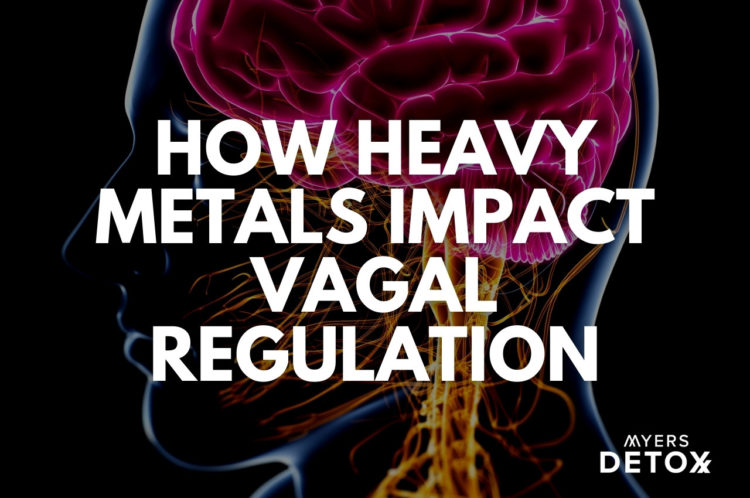How Heavy Metals Impact Vagal Regulation

The vagus nerve is getting a lot more attention these days as researchers continue to uncover the diverse roles that it plays in the maintenance of your nervous system.
Unfortunately, like many other vital structures in your body, your vagus nerve can become vulnerable to attack from pollutants. When this happens, it not only throws your nervous system off balance, but it can impact several other aspects of health due to the diverse roles that the vagus nerve plays physiologically.
Heavy metals are of particular concern due to their high affinity for your nervous system, making the potential danger of heavy metal burden in your body even more devastating.
In this article, you’ll learn:
- What your vagus nerve is and what its primary functions are
- How heavy metals impact the function of the vagus nerve
- How heavy metal toxicity can drive the stress response
- How to mitigate the damage of heavy metals
- What you can do to enhance the health of your vagus nerve
What Is The Vagus Nerve?

As one of the longest nerves in your body, the vagus nerve originates in the brain stem and travels all the way down to your abdomen. This nerve is one of the primary components of the gut-brain connection, creating a bridge between your enteric nervous system (governing the function of your digestive tract) and your central nervous system.
In fact, it’s your vagus nerve that carries information back and forth between your gut and your brain, allowing these two systems in your body to communicate[1].
Furthermore, due to its wide-reaching impact, your vagus nerve is responsible for various organ functions such as digestion, respiratory rate, heart rate, vasomotor activity, and certain reflexes.
The branch of your nervous system most impacted by the vagus nerve is your parasympathetic nervous system (PNS). The PNS is one of the branches of your autonomic nervous system (ANS), along with the enteric nervous system (ENS) and the sympathetic nervous system(SNS)[2].
If you’re unfamiliar, your sympathetic nervous system becomes activated in the presence of threat (real or imagined), and kicks your stress response into high gear. When sympathetic mode is activated, heart rate increases, blood pressure goes up, breathing becomes more shallow, and your blood flow starts to move to your limbs and away from your vital organs – so you can run or fight.
While this adaptation was crucial for our ancestor’s survival in the wild, today, an overactive sympathetic nervous system really just wears us down and often leads to health issues.
As a key regulator of the PNS, your vagus nerve helps to pull you out of sympathetic activation (fight or flight) and into rest and digest mode. When the vagus nerve is stimulated, your breathing slows down, heart rate and blood pressure decrease, and your blood once again flows to your vital organs[3].
How Heavy Metals Impact The Vagus Nerve
As you might imagine, having a healthy and functioning vagus nerve is crucial for not only your physical health but also your emotional wellbeing. When your vagus nerve is not properly toned, it can keep you stuck in fight or flight, draining your body of its vital resources and keeping you mentally on edge for a threat.
Unfortunately, many people today find themselves stuck in a perpetual state of fight or flight either due to stressors in their life or an inability to manage their nervous system due to environmental toxins like heavy metals.
It may sound like a strange correlation; how can heavy metals impact your ability to relax? But the truth is that when you’re exposed to heavy metals, the burden they cause to your body can affect almost every system and process you need to maintain homeostasis.
Furthermore, research shows that heavy metals, in particular, have an affinity for the central nervous system. This means that once metals get into your body – they target tissues like your brain, spinal cord, and structures like your vagus nerve[4].
Some research even shows that one of the most common pathways that pollutants take to get to your brain is via your vagus nerve[5].
And of course, when toxins accumulate in your vagus nerve, it can cause dysfunction in your ANS, which further drives imbalances in your ability to regulate stress (the fight or flight response). In fact, research shows that heavy metal exposure is associated with a decrease in something called heart rate variability (HRV)[6].
HRV is a direct measure of your body’s stress response; the higher your HRV, the more resilient you are to stress. HRV is also directly tied to the function of your vagus nerve, with research showing that toning your vagus nerve is one of the best ways to increase HRV[7].
Moral of the story; heavy metal exposure decreases the ability of your body to manage stress by directly impacting your vagus nerve –which is a crucial component to managing your stress response.
So, what can you do to mitigate your metal exposure and enhance the function of your vagus nerve? The answer is two-part:
- Lower your toxic load
- Enhance your vagal tone
Lowering Your Toxic Load

Reduce Exposure
Of course, the most straightforward way to mitigate the dangers of heavy metals is to avoid them altogether. The problem is that these toxic compounds are everywhere in our environment these days.
Everything from roadside runoff to industrial pollutants to pesticides and herbicides are infusing our natural environment with unprecedented levels of heavy metals. At this point, heavy metals have found their way into our food supply, drinking water, everyday personal care items, and even the air we breathe.
This means that avoiding heavy metals altogether is not really an option – but we can mitigate our exposure.
How? Bring awareness to your environment, and follow these key steps:
- Organic produce is not sprayed with pesticides that contain heavy metals – so opt for organic whenever possible.
- Get yourself a high-quality water filter to remove metals from your water supply. And unless you live near a freshwater spring in the middle of nowhere, you can be sure that there are metals in your water supply.
- Invest in an air purifier, at the very least for your bedroom, where you spend about eight hours a day.
- Support brands that use natural ingredients and avoid heavy metals. You would be surprised how many cosmetic brands have heavy metals lurking in their products. Go for natural brands that do heavy metal testing. A great website to use is EWG; this is the Environmental Working Group site that lists out high-quality brands that are safe.
Promote Detox To Maintain A Healthy System
The second piece to lowering your toxic load is promoting natural detoxification in your body. Although your body is naturally set up to detox unwanted compounds, in today’s world, we come into contact with far more toxins than we ever have in human history. This leads to a backup in our detoxification systems, and the burden can become more than your system is meant to handle.
The good news is that mother nature has provided us with nutrients that are targeted to support your body’s own detoxification systems. By incorporating detox-promoting nutrients into your diet on a daily basis, you can offer your body the support it needs to offset the unavoidable toxic load of the modern world.
It was exactly this concept that I had in mind when I created my Daily Detox powder. In the process of choosing foods and herbs to incorporate in Daily Detox, I researched the most effective compounds for promoting the body’s natural detoxification mechanisms while also supporting other systems in the body, such as metabolism, mitochondrial health, and digestion.*
I know that most people don’t have time to create tailor-made meal plans full of superfoods, so I made Daily Detox as a shortcut to ensure that my clients and I got everything we need maintain normal health in just 30 seconds per day.
At-Home Vagal Regulation
In addition to managing heavy metals directly, you can also enhance the health of your vagus nerve by direct stimulation. When you tone your vagus nerve using the activities below, it can help to strengthen its activity and enhance its ability to balance your autonomic nervous system.
Some simple practices to incorporate include:
Deep Breathing
Deep breathing is a simple yet powerful way to enhance parasympathetic activation. As mentioned previously, when your body is in sympathetic mode, your breathing tends to be quick and shallow, while parasympathetic mode is marked by deep, diaphragmatic breathing. While you can’t control your blood pressure, heart rate, or blood flow – you can adjust your breathing at will.
Research shows that when you slow down your breathing, it sends a signal to your brain that you are safe and relaxed, which stimulates your parasympathetic nervous system. How does your brain get this message? Through the stimulation of your vagus nerve[8].
Chanting or Singing
Eastern practices like yoga and Ayurveda have incorporated chanting for thousands of years as a way to calm the nervous system and reach elevated states of being. Today, research shows that chanting may be one of the most powerful ways to tone the vagus nerve and calm your mind and body.
One of the most popular mantras, “OM,” has been specifically researched for its ability to pull people into a state of parasympathetic dominance and peace[9].
In addition to the vibration that chanting creates in your throat, which impacts your vagus nerve, chanting and singing require you to elongate your breath, which, as you just learned, is a fantastic way to enhance the tone of your vagus nerve[10].
Meditation
Meditation is becoming increasingly popular as a way to manage stress and increase resilience. Research shows that when you meditate, it can naturally slow your respiratory rate and increase your heart rate variability[11].
By stimulating the parasympathetic response, meditation, in turn, primes your vagus nerve and enhances its activity. Over time, this can make it easier to switch over to parasympathetic mode during the day when you’re not meditating.
Laughter
Have you ever noticed that when you’re feeling low, all it takes is a good laugh to turn your mood around?
Much like chanting and singing, when you laugh, it changes the cadence of your breath. You end up holding the breath in and releasing it in fits of laughter naturally, which stimulates your vagus nerve. What’s more, research shows that laughter increases heart rate variability[12].
Cold Exposure
Cold plunging is a practice that’s gaining a lot of attention at the moment for its benefits associated with mitochondrial health and longevity. As it turns out, another benefit of cold exposure is its impact on your nervous system.
When you’re first exposed to cold temperatures, it activates the sympathetic nervous system, giving you a little shock. However, once your body acclimates a bit to the temperature, it creates a significant shift away from sympathetic into parasympathetic – like a sigh of relief that you are safe (although perhaps a bit uncomfortable). This shift happens as your vagus nerve becomes activated, kicking the parasympathetic mode into gear[13].
Luckily, cold exposure doesn’t have to be a brutal process; even 30 seconds of cold water while you’re showing can make a difference.
Takeaway
The toxic load of our environment doesn’t seem to be diminishing, and the impact it’s having on human health is becoming even more obvious as we are more stressed, drained, and sick than ever before.
While one person can’t change the entire environmental landscape, there are meaningful things you can do for yourself and your family to mitigate the damage of heavy metals and other pollutants. These include choosing high-quality natural brands for personal care, home care, and cosmetics, supporting organic farmers, and filtering your air and water whenever possible.
Simultaneously, as research continues to uncover the various roles that the vagus nerve plays in your body, learning to care for this vital nervous system structure can make a world of difference in how you feel and respond to life. Enhance vagal tone with deep breathing, chanting, laughter, singing, and meditation.
When used together, vagal regulation plus toxin mitigation can make a significant difference in the health of both your mind and body. And the good news is that these options are in your hands and easily accessible.
*These statements have not been reviewed by the FDA. Daily Detox is a dietary supplement and is not intended to diagnose, treat, cure, or prevent any disease. It is not intended to replace any medication or healing modality prescribed by your medical doctor. Please consult with your doctor before beginning a new supplement regimen.
Click Here for References+
- Bonaz, Bruno, Valérie Sinniger, and Sonia Pellissier. “The vagus nerve in the neuro-immune axis: implications in the pathology of the gastrointestinal tract.” Frontiers in immunology 8 (2017): 1452.
- https://www.ncbi.nlm.nih.gov/books/NBK539845/#:~:text=The%20autonomic%20nervous%20system%20is,sympathetic%2C%20parasympathetic%2C%20and%20enteric
- Breit, Sigrid, et al. “Vagus nerve as modulator of the brain–gut axis in psychiatric and inflammatory disorders.” Frontiers in psychiatry (2018): 44.
- Clarkson, Thomas W. “Metal toxicity in the central nervous system.” Environmental Health Perspectives 75 (1987): 59-64.
- Kim, Hyunyoung, et al. “Air pollution and central nervous system disease: a review of the impact of fine particulate matter on neurological disorders.” Frontiers in Public Health (2020): 921.
- Liao, Yi-Hsueh, et al. “Associations between personal exposure to metals in fine particulate matter and autonomic nervous system dysfunction among healthy adults.” Aerosol and Air Quality Research 20.8 (2020): 1842-1849.
- Ernst, Gernot. “Heart-rate variability—more than heart beats?.” Frontiers in public health 5 (2017): 240.
- Mason, Heather, et al. “Cardiovascular and respiratory effect of yogic slow breathing in the yoga beginner: what is the best approach?.” Evidence-Based Complementary and Alternative Medicine 2013 (2013).
- Kalyani, Bangalore G., et al. “Neurohemodynamic correlates of ‘OM’chanting: A pilot functional magnetic resonance imaging study.” International journal of yoga 4.1 (2011): 3.
- Vickhoff, Björn, et al. “Music structure determines heart rate variability of singers.” Frontiers in psychology 4 (2013): 334.
- Linares Gutierrez, Damisela, et al. “Meditation-induced states, vagal tone, and breathing activity are related to changes in auditory temporal integration.” Behavioral Sciences 9.5 (2019): 51.
- Dolgoff-Kaspar, Rima, et al. “Effect of laughter yoga on mood and heart rate variability in patients awaiting organ transplantation: a pilot study.” Alternative therapies 18.4 (2012): 53-58.
- Mäkinen, Tiina M., et al. “Autonomic nervous function during whole-body cold exposure before and after cold acclimation.” Aviation, space, and environmental medicine 79.9 (2008): 875-882.








